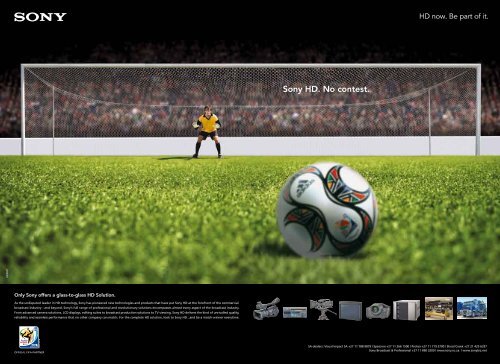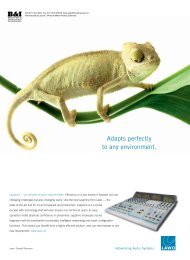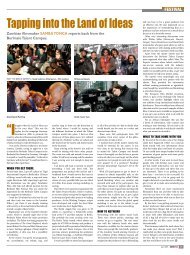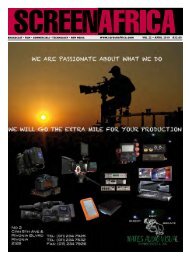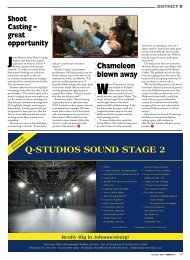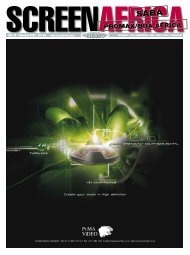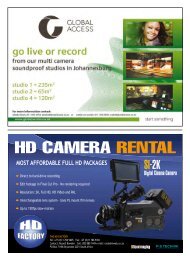Dowbload Part 2 - size: 2.0mb - Screen Africa
Dowbload Part 2 - size: 2.0mb - Screen Africa
Dowbload Part 2 - size: 2.0mb - Screen Africa
Create successful ePaper yourself
Turn your PDF publications into a flip-book with our unique Google optimized e-Paper software.
TRACKINGTECHNOLOGY CAMERAS<br />
Cameras in Action<br />
With the wide selection of good cameras available, it can be difficult to find a one which suits your particular<br />
needs. <strong>Screen</strong> <strong>Africa</strong> spoke to four cameramen about which cameras they prefer and why.<br />
18<br />
Sony VX-1000<br />
Sony PD-100<br />
Sony D30SP-BetaCam<br />
Sony D30-DVCam<br />
Sony DVW700 Digital BetaCam<br />
Sony PMW-EX1 HD<br />
Sony PMW-EX3 HD<br />
Panasonic HDX-900<br />
Panasonic HVX-200<br />
SCREENAFRICA – May 2009<br />
Jacques Goosen<br />
JACQUES GOOSEN<br />
Cameraman for SANHU –<br />
The South <strong>Africa</strong>n Natural History<br />
Unit. The company is based in the<br />
Kruger National Park and produces<br />
a range of wildlife and natural history<br />
programmes for international<br />
distribution.<br />
What cameras do you<br />
use and why?<br />
JG: I have various cameras of my<br />
own at the moment, all being Sony.<br />
They are robust and reliable if you look<br />
after them. I have kept all of them since<br />
1996 when I bought my very first<br />
camera after leaving the SABC for the<br />
big freelance world.<br />
I currently have the following in<br />
working condition and a couple of<br />
them, pure ornaments from the past.<br />
These are my Sony VX 1000 and two<br />
Sony PD 100s, which all did their time<br />
in some really harsh and rugged<br />
conditions with some great results at<br />
that time, before all the new generation<br />
of cameras arrived (PD 150, 170 and<br />
the Z1s).<br />
The VX1000 was only two days old<br />
when it was trodden on by buffalo and<br />
it then went on to do another five years<br />
of work before I put it to retirement on<br />
the bookshelf. It was a great camera at<br />
the time, very user friendly and great<br />
quality picture for its price tag.<br />
Some of my cameras still working<br />
and in good condition are: a Sony D30<br />
Betacam SP camera – 13 years old<br />
(used for training interns and students),<br />
a Sony D30 DVCam camera – 10 years<br />
old (currently the camera mostly used<br />
for filming SABC productions), and<br />
then the good old Sony 700 Digital<br />
Betacam camera – 12 years old and still<br />
going (used mainly for international<br />
clients that are not shooting on HD<br />
yet), which has been my favourite<br />
camera to date. This camera has filmed<br />
in very dusty and hot conditions, over<br />
rough terrain and yet with minimal<br />
repairs, other than its normal services<br />
and parts.<br />
I have recently acquired two small<br />
HD cameras, namely the Sony EX-1<br />
and the Sony EX-3, to my stable of<br />
Sony cameras.<br />
What are some of the best<br />
features of these cameras?<br />
JG: Since I have so many cameras,<br />
which have all had their day in the<br />
limelight, I’d rather discuss the new<br />
cameras I’ve just bought. Although I’ve<br />
only filmed twice with the EX-1 and<br />
once with the EX-3 to date, they are<br />
different.<br />
The EX-1 is a great little camera,<br />
excellent picture, great audio,<br />
manoeuvrable, compact and versatile.<br />
It’s not a big camera, far from it, but has<br />
some great features in that it has a<br />
proper focus, iris and zoom ring on the<br />
lens for cameramen who prefer to use<br />
manual focus and iris. An added<br />
feature, which I like, is a proper zoom<br />
server grip that also rotates position.<br />
This and the <strong>size</strong> of the camera I found<br />
very handy recently in a chopper where<br />
there was barely room for me, yet I was<br />
able to film holding the camera on its<br />
zoom grip away from me to record a<br />
great high quality shot with ease. It’s<br />
not possible with a bigger camera.<br />
The Sony EX-3 is a bigger version of<br />
the EX-1 and comes with a better<br />
viewfinder, is switchable from colour to<br />
B&W and that can be used as a normal<br />
LCD screen like the EX-1. This came<br />
in very handy while filming at night<br />
catching crocodiles in the Olifants river<br />
recently, as the lighting conditions were<br />
extremely low, due to the technique<br />
used to catch these crocs, and the focus<br />
on the camera was critical especially in<br />
HD. The viewfinder made it a bit<br />
easier than the LCD screen of the<br />
EX-1. The only problem I had with the<br />
camera was that it’s not really a<br />
shoulder mounted camera and needs an<br />
additional shoulder brace to use your<br />
shoulder as support. I found one can<br />
only support the camera against the<br />
body, but then the weight rests mainly<br />
on your wrist holding onto the zoom<br />
grip. Other than that the pictures are<br />
great and the camera is user friendly.<br />
ROB WALDRON<br />
Wildlife filmmaker of Wild Dog<br />
Productions.<br />
What cameras do you<br />
use and why?<br />
RW: I use two Panasonic cameras –<br />
the full high definition HDX900 and<br />
the P2 camcorder, the HVX200. One<br />
of the main reasons we chose the<br />
HDX900 is because it greatly simplifies<br />
the post-production process. Unlike<br />
most cameras, the HDX900 has both<br />
HDSDI and Firewire 800, which<br />
means that footage can be ingested<br />
directly onto hard drives or into nonlinear<br />
editing systems. This allows for<br />
very rapid turnaround from shoot to<br />
edit. We tend to use the HDSDI for<br />
high end productions for ingestion into<br />
an Avid and the Firewire 800 for high<br />
speed turnover, ingested into a Final<br />
Cut Pro. I particularly like the cine<br />
‘filmlike’ settings on the HDX900<br />
which give beautiful and warm images.<br />
We’ve tried a competitive camera and<br />
found it difficult to get the same degree<br />
of warmth.<br />
We often use the HDX900 together<br />
with the HVX200 and can dial in a<br />
very similar look on both cameras for<br />
simultaneous use, particularly when<br />
we’re doing fast action-based work like<br />
game capture. In such instances the<br />
HDX900 would be on a tripod as the<br />
main camera, while the HVX200 is<br />
used nearer the action, being lighter<br />
and smaller. The beauty in postproduction<br />
is that the images from both<br />
cameras are compatible. Also, both<br />
cameras process data at 100MB per<br />
second. None of the smaller<br />
competitive cameras can process data at<br />
the same rate. A handy feature on the<br />
cameras is the variable frame rates for<br />
slow motion and time lapse. Both<br />
cameras have been used in several<br />
<strong>Africa</strong>n countries and endured extreme<br />
conditions such as heat, humidity, dust<br />
and moisture.<br />
We’ve used both cameras to film a<br />
13-part series called The Zoo That<br />
Saved The World, about South <strong>Africa</strong>’s<br />
National Zoo in Pretoria. This is rated<br />
as one of the top five zoos in the world<br />
and the series documents the role it<br />
plays in preserving endangered species.<br />
It was shot partly at the zoo and on<br />
location in Mozambique, Botswana<br />
and KwaZulu-Natal. The series is<br />
currently in post-production and was<br />
commissioned by e.tv’s affiliate, the<br />
Natural History Unit.<br />
I’m very happy with our HD choice<br />
and think it’s the most cost effective<br />
system in the market.<br />
– to page 20
Leap Ahead<br />
with Spescom MediaIT.<br />
In today’s ever changing broadcasting environment, companies consistently compete for a competitive edge.<br />
To leap ahead, your company requires the integrator of choice for total broadcasting solutions.<br />
Spescom MediaIT has the expertise and know how to deliver best of breed integrated broadcasting solutions,<br />
effectively, efficiently, you gain competitive advantage, and stay ahead.<br />
Spescom MediaIT, your partner of choice for integrated broadcasting solutions.<br />
Tel: (011) 266 1500<br />
UNDERSTAND • INNOVATE • DELIVER<br />
Fax: (011) 266 1543<br />
E-mail:<br />
broadcastsales@spescom.com<br />
Web: www.spescom.com<br />
10-8-0-0-275-0
TRACKINGTECHNOLOGY CAMERAS<br />
Trevor de Kock<br />
Russell Belter<br />
Panasonic HPX-2100<br />
Panasonic HVX-200<br />
Sony XDCAM PDW-F350<br />
Panasonic HDX-900<br />
from page 18<br />
TREVOR DE KOCK<br />
Wildlife filmmaker of Pelican<br />
Pictures.<br />
What cameras do you<br />
use and why?<br />
TDK: I use the Panasonic<br />
HPX2100 as my main camera and its<br />
smaller brother, the HVX200, as my<br />
secondary camera. I chose these<br />
cameras because I decided to go the P2<br />
tapeless route, which is increasingly<br />
becoming the trend worldwide as it<br />
moves towards solid state, and with<br />
broadcasters like the BBC also going<br />
tapeless.<br />
One of the best features of the<br />
HPX2100 is the pre-record button,<br />
which memorises up to eight seconds<br />
before the action takes place. For a<br />
wildlife cameraman this is obviously a<br />
great facility. Ironically, this way you<br />
end up saving on footage rather than<br />
wasting it. The camera also allows you<br />
immediate access to shots, with<br />
thumbnails displayed on the menu.<br />
I am currently working on a 13-part<br />
reality-based ‘animal soapie’, which<br />
focuses on the daily lives of a troop of<br />
baboons. I’ve already been filming the<br />
series on this camera for two years.<br />
There’s never a dull moment in baboon<br />
society so the series is certainly<br />
amusing, entertaining and dramatic at<br />
times.<br />
One challenge I’ve encountered is the<br />
time it takes to download the P2 cards.<br />
I have to do this every night after a long<br />
day in the bush just to check my shots<br />
and it takes a long time. Having said<br />
that, Panasonic has just launched [at<br />
NAB] the E-class P2 cards, which are<br />
about a third of the cost of the cards I’m<br />
using. This means that I will be able to<br />
use more cards on shoots.<br />
In terms of accessories used on the<br />
HXP2100, I have had the new<br />
Panasonic AVC Intra codec installed,<br />
which has various advantages. I use two<br />
Fujinon HD lenses, a 13x4.5 and a<br />
25x11.5 on the camera.<br />
A Bebop pan bar remote control<br />
allows me to shoot and zoom with one<br />
hand. A lot of these cameras are<br />
specifically designed for ENG, whereas<br />
wildlife filmmakers have to use big<br />
lenses on them so they become<br />
awkward to manoeuvre. Another<br />
accessory is the P2 store which I use in<br />
the field for emergencies. It allows you<br />
to download up to an hour of footage so<br />
it’s very useful.<br />
I am shooting at 720 50p which gives<br />
me the option of slowing down footage.<br />
A lot of wildlife filmmakers are going<br />
the Panasonic route. I haven’t tried any<br />
other competitive cameras, having<br />
decided early on to stick to P2. One<br />
issue that is common to all filmmakers,<br />
regardless of which cameras they use, is<br />
that unlike other most other cameramen<br />
we have to invest in our own<br />
cameras. The rapid rate of technology<br />
means that these cameras may be<br />
redundant in a year or two, which<br />
impacts on your personal investment.<br />
RUSSELL BELTER<br />
WildCam – the company has eight<br />
full-time cameramen and they shoot<br />
everything from Supersport news to<br />
wildlife documentaries for National<br />
Geographic and Discovery.<br />
What cameras do you<br />
use and why?<br />
RB: I have tried all the cameras out<br />
there – first the Digi Beta, then<br />
DVCPro, DVCam and then three<br />
years ago I moved to XDCam and<br />
finally in 2007 just before the Rugby<br />
World Cup I moved to XDCam HD.<br />
I am not a purist and have no<br />
loyalties to any brand. I always look at<br />
the market and try to gauge what the<br />
broadcasters are looking for. It’s that<br />
fine balance between quality and<br />
affordability. Just last year I purchased a<br />
new DVCPro HD 100 camera for the<br />
end of the year Springbok Rugby Tour.<br />
I have been using the XDCam brand<br />
for more than three years and have<br />
never sent a camera back in for a repair<br />
and the format has never let me down<br />
on a shoot. I have only been using the<br />
DVCPro for six months and have not<br />
yet formed an opinion.<br />
I find the XDCam workflow to be<br />
far superior to the DVCPro. Shooting<br />
on full HD, Final Cut Pro sometimes<br />
struggles to read the P2 HD footage,<br />
whereas the XDCam workflow with<br />
FCP is flawless. Both formats are not<br />
that much faster when it comes to the<br />
ingesting from the camera, but there is<br />
one obvious basic difference. When<br />
viewing the proxy files on XDCam you<br />
can give the proxy In and Out points<br />
and then ingest only the footage you<br />
need for your field edit with the<br />
knowledge that your archive remains<br />
on the Blue Ray disc. On the DVCPro<br />
side you have to ingest all the material<br />
and then edit so that you can free up<br />
the P2 disks to continue shooting.<br />
In terms of archiving, there is no<br />
comparison. In an attempt to save<br />
budget I only bought three P2 chips for<br />
my DCVPro camera and now find<br />
myself continuously having to buy extra<br />
external hard disks to archive my<br />
footage when on a shoot. Just last week<br />
I travelled to the UK to shoot interviews<br />
for the Lions Rugby Tour and<br />
found myself sitting up until late at<br />
night transferring the data from my P2<br />
to a hard disk. I can honestly tell you<br />
that my stress levels have increased<br />
dramatically since I tried the P2<br />
standard. Putting your archive on Blue<br />
Ray is the answer.<br />
If you are ever worried about<br />
XDCam as an acceptable format then<br />
you had to be with me at the 2008<br />
Beijing Olympics. ABC, the biggest<br />
broadcaster at the Olympics, has<br />
accepted XDCam as their HD<br />
acquisition format. When you stand in<br />
the mixed zone at the swimming and<br />
35 of the other 40 cameraman all have<br />
XDCam, then you know you are on<br />
the right track.<br />
Quality is also a major issue. With<br />
the new XDCam camcorder recording<br />
HD material at up to 50Mb/s onto<br />
Dual Layer Disc – three 2/3-inch<br />
CCD sensors, full 1920 x 1080 4:2:2<br />
operational and 1080/720 swithcables<br />
the argument is not worth my time.<br />
It’s simple – I want a camera<br />
that is acceptable to all the major<br />
broadcasters.<br />
20<br />
SCREENAFRICA – May 2009
K2 SUMMIT MEDIA CLIENT<br />
SPEED IS APPRECIATED<br />
WHEN YOU NEED IT MOST.<br />
The Grass Valley K2 Summit combines an array of special<br />
features that set a new standard for turn-around speed in<br />
replay applications. Architected internally for direct<br />
file-access from record to play-out, Summit helps you see<br />
files faster. And remarkably, all this power comes in an<br />
efficient design optimized for space-challenged environments.<br />
It’s Gotta Be A Grass!<br />
For more information on K2 Summit visit<br />
www.grassvalley.com/summit
TRACKINGTECHNOLOGY EDITING<br />
Editing tips: CRASH! Recover your cut<br />
Susan Scott and Candice van der Valk, members of the South <strong>Africa</strong>n Guild of Editors (SAGE), have for many<br />
years been cutting HD documentaries for National Geographic, Discovery Channel and Animal Planet. Here they<br />
share their technical experience of working on Avid and Final Cut Pro.<br />
Susan Scott: I start to feel old, really<br />
old when I remember cutting on the<br />
old Mac Quadras, which used to crash<br />
regularly. In those days I accessed<br />
Avid’s Attic probably once a fortnight<br />
for a corrupt bin that wouldn’t open or<br />
God forbid, a sequence that wouldn’t<br />
play. Nowadays, the editing systems are<br />
more stable and thankfully our trips to<br />
the Attic are not as frequent. But there<br />
comes a time when despite your<br />
brilliant housekeeping and making<br />
gazillion duplicates of your sequences,<br />
you need to go back to an earlier<br />
sequence.<br />
Of course you copy everything, you<br />
just didn’t copy that sequence with<br />
those cuts. And now you’re headed for a<br />
trip to the Attic and you can’t<br />
remember how to get there, let alone<br />
find it because it’s been so long since<br />
you were last there. And you’d better<br />
believe the procedure has changed.<br />
Like everything, except the damn<br />
effects palette, Avid makes subtle<br />
changes on every teeny little release.<br />
So here’s a quick update on how to<br />
access your attic:<br />
Open the Attic’s project folder and<br />
then the Bins folder – look at the image<br />
on the left if you don’t know where your<br />
Attic is. Double click the folder for the<br />
bin you want to recover, in this case the<br />
Sequences Bin. Make sure you select<br />
View >Details to see the Date<br />
Modified. A back-up bin file has the<br />
same name as the bin, but with a<br />
number appended to it. The highest<br />
number indicates the latest bin saved.<br />
Choose the back-up bin file you would<br />
like to retrieve. Copy and paste the file<br />
onto your desktop, as you want a copy<br />
of the file while leaving the original in<br />
the Attic.<br />
The Avid will also not open a bin file<br />
directly from the Attic. Don’t be<br />
tempted to type the Avid Bin extension<br />
(.avb) onto the file and use it as your<br />
“new” bin. This workflow is<br />
recommended by Avid; it’s a bit longer<br />
but safer. Re-open or maximise your<br />
Avid Application and close all your<br />
bins, either manually or Window<br />
>Close All Bins (Avid does not allow a<br />
Platform: AVID<br />
bin and a copy of a bin to<br />
be open at the same time,<br />
so play it safe and close all<br />
your bins while retrieving<br />
from the Attic).<br />
Select File >Open Bin,<br />
and select All Files (*.*)<br />
from the Files of Type list<br />
and navigate to the<br />
desktop where you will<br />
open your back-up bin<br />
file. It will now open in<br />
your project window.<br />
Create a new bin, for this<br />
example we have called<br />
this one, Sequence RECOVER. Select<br />
the sequence from the back-up bin file<br />
and drag it into the new bin. Delete<br />
your back-up bin file in the Other Bins<br />
folder as well as deleting it from the<br />
desktop. Its job is done now!<br />
Candice van der Valk: The thing<br />
about Final Cut Pro is that you can<br />
change just about anything within it to<br />
Platform: FCP<br />
customise your working environment.<br />
Great for those who enjoy technical<br />
wizardry but for those of us who enjoy<br />
working in an application the way it<br />
was intended – here are a few<br />
guidelines:<br />
With Final Cut Pro you have to (at<br />
the start of every project) set up all your<br />
preferences. So as far as the Autosave<br />
Vault goes you need to set it up front.<br />
Launch FCP. Go to the Final Cut<br />
Pro tab > Click on System Settings in<br />
the scratch disk setting – see diagram.<br />
Set your Autosave Vault to your<br />
internal drive as these are much more<br />
stable than external drives. Now you<br />
are ready to start your project.<br />
Down the line you might need to<br />
recover a past sequence and you can<br />
either restore from within your current<br />
project by going to File > Restore<br />
Project and then select the date you<br />
wish to restore. BUT if you are trying<br />
to find a project from months back, you<br />
should hide FCP (cmd-H) and go into<br />
the internal hard<br />
drive originally<br />
selected to store your<br />
autosaved projects. In<br />
that selected drive<br />
will be a folder called<br />
Final Cut Pro<br />
Documents > and<br />
inside that folder is a<br />
folder called<br />
Autosave Vault ><br />
Click on that folder<br />
and select the project<br />
file you require.<br />
They are ordered in<br />
date and time order.<br />
Double click the one<br />
you require which<br />
will open up in FCP<br />
> check you have the<br />
correct project. Go to<br />
file and “Save As”<br />
and rename your<br />
project and save it in<br />
the appropriate<br />
folder. Once you<br />
are happy and<br />
working again…<br />
BACK-UP!<br />
BACK-UP!<br />
BACK-UP!<br />
Join us next time where we’ll discuss<br />
the various ways to navigate in and<br />
around your timeline on both<br />
platforms!<br />
To find a SAGE Editor please<br />
visit: www.editorsguildsa.org<br />
Tel: (011) 266 1500<br />
Fax: (011) 266 1543<br />
E-mail:<br />
broadcastsales@spescom.com<br />
Web: www.spescom.co<br />
Integrator of Choice<br />
22<br />
SCREENAFRICA – May 2009
FILM<br />
White Wedding<br />
By Karen van Schalkwyk<br />
on the right road<br />
TRIP DOWN THE AISLE – Lead actors Kenneth Nkosi, Jodie Whittaker and Rapulana Seiphemo in White Wedding<br />
The latest in a spate of<br />
independent South <strong>Africa</strong>n films<br />
to be screened on the local circuit<br />
is White Wedding, which opened<br />
on 29 April on 38 screens. Distributed<br />
by Ster-Kinekor, this romantic comedy,<br />
also part road trip film, is about<br />
making it to the wedding on time. The<br />
film was scripted by Jann Turner<br />
(director), Kenneth Nkosi (Tsotsi,<br />
Surprise) and Rapulana Seiphemo<br />
(Tsotsi, Jerusalema, Hijack Stories).<br />
Turner, who has directed television,<br />
says that her film directing debut was<br />
fantastic. “The difference with film and<br />
TV is that film is much bigger.<br />
Literally, the aspect ratio makes for a<br />
bigger picture. It’s also bigger in that<br />
the crew is larger, there is more time<br />
per scene and yet the stakes feel higher.<br />
A film is also a complete work and not<br />
an episode or series of episodes.”<br />
The hundreds of hours of television<br />
she has directed have stood her in good<br />
stead. “Television taught me the<br />
importance of making sure you meet<br />
the deadlines. It gave me lots of practice<br />
at being able to organise and shoot to<br />
schedule. This comes in very handy<br />
when you have only 18 days to shoot a<br />
feature.”<br />
Regarding the inspiration for the<br />
film, Turner explains: “About seven<br />
years ago Raps and Kenny and I took a<br />
road trip from Jo’burg to Cape Town.<br />
We’re friends and we talked a lot about<br />
relationships that holiday. We also<br />
talked movies. The experience of being<br />
on the road together combined with<br />
what we had discussed at<br />
the time was the seed for<br />
White Wedding.”<br />
Turner says that when they wrote the<br />
script they worked in a collaborative<br />
way. “First we had a meeting to<br />
generate our ideas. Then the step<br />
outline and more meetings to define<br />
that, followed by the writing process<br />
where we sat for days on end working<br />
on the script. I sat with my fingers on<br />
the keyboard trying desperately to keep<br />
up with Raps and Kenny as they talked<br />
so fast and acted out some of the<br />
scenes.”<br />
Turner adds that while they might<br />
argue a lot, “we would never leave the<br />
room without coming up with a<br />
solution to the problem. I am not a<br />
good collaborator, but the energy was<br />
great and the three of us really worked<br />
well together.”<br />
Nkosi elaborates: “Writing together<br />
was great. We created our story and<br />
characters and made joint decisions in<br />
the writing process. When we had to<br />
perform, I had Jann to guide me as a<br />
director and Rapulana to play against<br />
as an acting partner.<br />
Seiphemo adds that the whole<br />
experience was overwhelming. “When<br />
we set out to write this story we never<br />
imagined it would turn out the way it<br />
did. We spent countless hours with<br />
Jann at the computer or at times with a<br />
tape recorder. Finally we ended up with<br />
a script that was a South <strong>Africa</strong>n story<br />
that was funny, wittty and really<br />
adorable.”<br />
Turner says that as always, the<br />
biggest challenge was coming up with<br />
the money. “Time and money were the<br />
big obstacles. Making something as<br />
beautiful as possible and as funny and<br />
real as possible within those constraints<br />
was the daily battle. Fortunately we had<br />
a fantastic crew, highly talented and<br />
experienced actors and great locations.<br />
It would have been nice to have more<br />
time so that we could have got more<br />
coverage, but the truth is that the script<br />
didn’t need a fancy visual treatment.<br />
We needed to capture the life that was<br />
being created in front of the camera.”<br />
Nkosi says that for him the biggest<br />
challenge, “was when the three of us<br />
were writing together and we<br />
disagreed. We could argue freely about<br />
it, whereas when we were with the cast<br />
and crew, if any disagreements<br />
emerged, we had to exercise extreme<br />
control.”<br />
Turner says most of her directing<br />
style and attitude to directing depends<br />
on the script and what you are given. “A<br />
good script is crucial and that will tell<br />
you most of what you need to know<br />
about how the film should look and<br />
feel. I like strong stories and good<br />
performances, so I am probably an<br />
actor’s director. On the film I worked<br />
closely with Willie Nel, our DOP, and<br />
we were in strong agreement about how<br />
the film should look and feel.”<br />
Turner says that the response to the<br />
film so far has been great. “We<br />
screened the film in Britain to a mostly<br />
English audience and they laughed as<br />
hard as the South <strong>Africa</strong>ns. I think the<br />
film is universal. It is really wonderful<br />
to watch the local audiences because<br />
they really like the film and delight in<br />
our local humour. The audience at the<br />
Cape Winelands Film Festival gave us<br />
a standing ovation.”<br />
Turner says she is excited by the<br />
current development of the local<br />
industry. “There are more South<br />
<strong>Africa</strong>n films coming out and it is<br />
starting to feel more like an industry. It<br />
feels great to be working in South<br />
<strong>Africa</strong> right now.”<br />
Nkosi adds: “It is great with a film<br />
like White Wedding to see South<br />
<strong>Africa</strong>ns laughing at themselves. This<br />
is what we are and we should be proud<br />
of it. There are so many of us making<br />
our first movies. We are all making<br />
mistakes and learning from them.<br />
Filming our own stories is so important<br />
and White Wedding is a good example.”<br />
Seiphemo concludes: “We are writing<br />
South <strong>Africa</strong>n stories that people can<br />
identify with and that is something<br />
to cherish.”<br />
24<br />
SCREENAFRICA – May 2009
MA<br />
- T: the +230 DOPS 206 choice 333 in <strong>Africa</strong><br />
South <strong>Africa</strong> plays host to three International feature films in the first quarter of 2009. All are shot on Kodak<br />
motion picture film stock, a tacit reinforcement of the continued reliance and confidence in the use of film<br />
as the premiere shoot format, and on Kodak motion picture film stock to provide the highest quality and most<br />
reliable results when there is no compromise.<br />
Directed by Clint Eastwood, the filmatic version of the John Carlin book the<br />
Human<br />
E:<br />
Factor looks<br />
richards@mediafilmserv<br />
at life for Nelson Mandela after the fall of apartheid in South<br />
<strong>Africa</strong> during his first term as president when he campaigned to host the 1995<br />
Rugby World Cup event as an opportunity to unite his countrymen. Human Factor<br />
stars Matt Damon and Morgan Freeman. The DOP is Thomas Stern ASC who used<br />
Kodak VISION3 500T 5219 almost exclusively. Panavision supplied cameras, grips<br />
and film stock.<br />
Shot in Cape Town the Warner Premiere Free Willy 4 shot approximately 280,000<br />
feet of Kodak VISION2 250D 5205, VISION2 50D 5201, and VISION3 500T<br />
5219 for water, days, nights, interiors and exteriors. Free Willy 4 is a South <strong>Africa</strong>n<br />
and German co-production produced by David Wicht of Film Afrika. The DOP is<br />
Rob Malpage SASC. Panavision supplied cameras, grips and film stock.<br />
Shooting commenced recently in Johannesburg on the movie The Bang Bang<br />
Club, a drama depicting the true-life experiences of four combat photographers<br />
capturing the final days of apartheid in South <strong>Africa</strong>. Based on an amazing story<br />
of photographers Greg Marinovich, Kevin Carter, Ken Oosterbroek and Joao Silva<br />
it is based on the semi-autobiographical book written by the surviving Club<br />
members, Silva and Marinovich. The Bang Bang Club is a Canadian/South <strong>Africa</strong>n<br />
co production with Daniel Iron of Foundry Films Inc Canada and Lance Samuels of<br />
Out of <strong>Africa</strong> Entertainment (Pty) ltd.<br />
DOP Miroslav Baszak talks about the film and<br />
his reasons for choosing Kodak film stock: “I live<br />
and work out of Toronto Canada and I work all<br />
over the world. I shoot commercials and features.<br />
My first <strong>Africa</strong>n Movie was Shake Hands with<br />
the Devil, a Roméo Dallaire Movie based on a<br />
Commander of the UN forces in Rwanda – during<br />
the xenophobia in the early 90’s, and I have done<br />
a variety of movies of different types and genres,<br />
including Land of the Dead by George A. Romero.<br />
This is however my first project in South Arica and I must say that you have amazing<br />
crews, a great country and great weather. I would come back, I could very well<br />
stay here!.<br />
The shoot is 30 days – it’s a challenging shoot because of the tight schedule – we<br />
could use a couple more shooting days but that’s what we have and we will make it<br />
work. Its also different because you sometimes come here to use South <strong>Africa</strong> as a<br />
location only but this time we are shooting a South <strong>Africa</strong>n film so we are not here<br />
to shoot the beauty of the South <strong>Africa</strong>n country – we are shooting in townships,<br />
we are shooting in downtown Jhb, so we are more about the people in South <strong>Africa</strong><br />
than just the landscape.<br />
We are shooting on two 35mm Arricams running at 3-perf and we are using three<br />
Kodak motion picture stocks namely VISION2 250D 5205, VISION2 50D 5201,<br />
and VISION3 500T 5219. We have had three days of shooting thus far and I have<br />
seen the dailies and I am extremely happy. One single reason that I wanted to use<br />
Kodak stock here was simple. Basically 5201 is the stock that I couldn’t imagine<br />
shooting this movie without, because it’s a daylight stock with extreme latitude<br />
and fantastic contrast and the way it penetrates blacks. It’s a great stock – we<br />
have a situation where we have a lot of battle scenes, where we are using multiple<br />
cameras, I felt that this is by far the best stock to handle it. We have high contrast<br />
situations with a lot of black skin tones. Any other stock you can work around but<br />
I felt that I needed the best and this is the reason I chose Kodak stock which was<br />
supplied by Media Film Service.<br />
We are shooting between six and eight thousand feet a day, and because we are<br />
shooting 3-perf we are getting about 25% more per foot. The processing and dailies<br />
transferring are being done in Toronto as part of the co-production deal, and has<br />
nothing to do with the facilities in South <strong>Africa</strong>. It does however mean that we only<br />
see the dailies about three days after the shoot and this is via internet streaming,<br />
which is not ideal, but I have worked on projects like this before, and since I know<br />
the stock well and I can rely on it totally and I know my exposures, I am completely<br />
confident the results will be good. It takes another couple of days for the DVD’s to<br />
arrive, and these I need to confirm the quality is good. All the post production will<br />
be in Toronto including the digital intermediate.<br />
Pudding Telecine Services, best described as offering ‘Creative<br />
grading solutions’ has further increased its faith in film<br />
origination through the recent purchase of a second Rank Cintel<br />
C-Reality HD film scanner together<br />
with a Baselight HD grading system,<br />
thereby firmly entrenching itself as<br />
one of the foremost transfer houses in<br />
South <strong>Africa</strong>. Colourist and co-owner<br />
Craig Simonetti remains convinced that film<br />
is still the premiere origination format, and the<br />
purchase of a second C-Reality emphasises<br />
this.<br />
“I would only advise shooting on another format if there are budget problems<br />
Simonetti observes. The majority of our work is commercials, and about 80%<br />
of these are shot on film. We have recently completed the transfers of a<br />
commercial for South <strong>Africa</strong>n Tourism shot on Kodak VISION2 250D 5205 and<br />
VISION2 200T 5217 and a commercial for Vodacom shot on Kodak VISION2<br />
250D 5205. The results are outstanding.<br />
I have been in this business for almost 20 years and I can say with confidence<br />
that my preference is for Kodak stock. Kodak appear to keep ahead of the<br />
best digital technology origination formats through continual development<br />
and the introduction of new stocks. I am keenly awaiting my first job on the<br />
new Vision3, and am equally excited about the opportunities that this second<br />
Telecine will bring in terms of our ability to now handle long format work as<br />
well as commercials“.<br />
AGENTS:<br />
MEDIA FILM<br />
SERVICE<br />
MEDIA EQUIPMENT<br />
RENTALS MAURITIUS<br />
PANAVISION CINEGATE SOUTHERN<br />
TAKE 2 FILMS<br />
LIGHTING<br />
JHB<br />
T: +27 11 258 5000<br />
F: +27 11 258 5091<br />
E: geoff@mediafilmservice .com<br />
KZN<br />
T: +27 31 569 3000<br />
F: +27 31 569 3067<br />
E: billy@mediafilmservice.com<br />
MA<br />
T: +230 206 333<br />
E: richards@mediafilmservice.com<br />
JHB<br />
T: +27 11 314 1748<br />
F: +27 11 314 1749<br />
E: james.barth@panavision.za.com<br />
CPT<br />
T: +27 21 556 6474<br />
F: +27 21 556 6477<br />
E: info@cinegate.co.za<br />
JHB<br />
T: +27 11 887 9351<br />
F: +27 11 887 9382<br />
E: johnharrison@southernlighting.co.za<br />
KZN<br />
T: +27 83 295 7905<br />
F: +27 31 569 3067<br />
E: bruce@southernlighting.co.za<br />
CPT<br />
T +27 21 410 1540<br />
F: +27 86 5248502<br />
E: leighann@take2films.co.za<br />
CPT<br />
T +27 21 511 3300<br />
F: +27 21 511 3395<br />
E: antony@mediafilmservice.com<br />
CPT<br />
T: +27 21 555 1780<br />
F: +27 21 555 1828<br />
E: tony.eddy@panavision.za.com<br />
CPT<br />
T: +27 83 553 2708<br />
E: patrickkwaan@absamail.co.za


